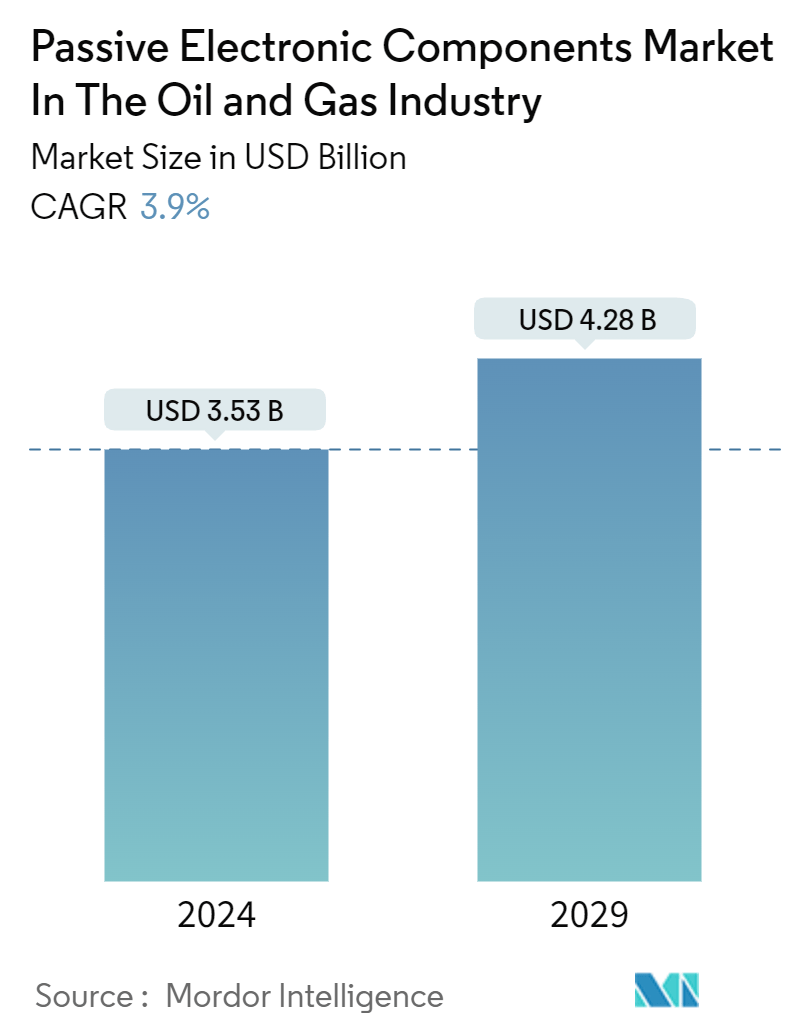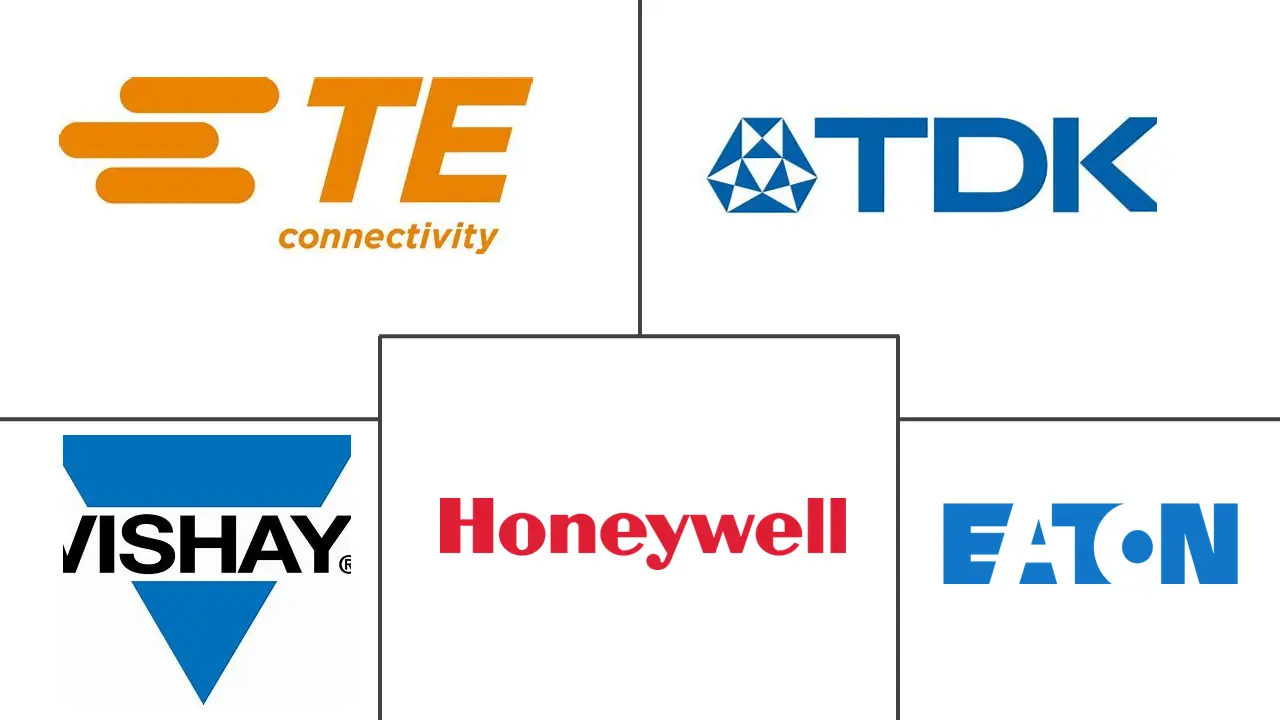Market Size of Passive Electronic Components Industry In The Oil & Gas Industry

| Study Period | 2021 - 2029 |
| Market Size (2024) | USD 3.53 Billion |
| Market Size (2029) | USD 4.28 Billion |
| CAGR (2024 - 2029) | 3.90 % |
| Fastest Growing Market | Asia Pacific |
| Largest Market | North America |
| Market Concentration | Medium |
Major Players
*Disclaimer: Major Players sorted in no particular order |
Passive Electronic Components in Oil & Gas Market Analysis
The Passive Electronic Components Market In The Oil & Gas Industry is expected to grow from USD 3.53 billion in 2024 to USD 4.28 billion by 2029, at a CAGR of 3.9% during the forecast period (2024-2029).
The oil and gas industry has a high demand for passive electronic components as electronic components used in this market must withstand high vibration frequencies at high temperatures and voltages.
- The passive components are able to perform in harsher environments, with extreme temperatures, vibration ratings, dust, liquid resistance specifications, etc. The oil & gas industry requires high-temperature capacity components that can resist temperatures exceeding 392°F. Passive electronic components in the oil & gas industry find application in downhole sensors, downhole logging tools, downhole pumping electronics, and others.
- Furthermore, passive electronic components offer high-end benefits to the oil & gas industry, such as stable and predictable capacitance, increased tool reliability and reduced risk of unexpected failure, shock and vibration, system design complexity, and improved installations. With the rising oil exploration and production activities across the globe, along with the integration of high-tech equipment and electronic components, the demand for passive electronic components has increased.
- The oil and gas industry is expected to witness steady growth in the coming years, owing to plans for its development. The industry is adopting automation in multiple processes due to these cost-cutting activities. The increasing use of IoT and automation in the industry to improve production, optimize equipment, and monitor remote areas, has fueled the market growth. IoT solutions and automation allow oil & gas facilities to gain detailed visibility into their process or equipment and increase efficiencies.
- Moreover, the regional government's fuel subsidies and lower oil prices further fuel the demand for oil and gas consumption by various end-use industries, creating new growth opportunities for the studied market. For instance, the Abu Dhabi National Oil Company or ADNOC, a state-owned oil company of the United Arab Emirates, announced its plans to add a third refinery to the complex as part of a USD 45 billion downstream development investment to develop flexibility in refining and processing other grades. The new refinery will have a capacity of 600,000 b/d, offering the entire complex a total capacity of 1.5 million barrels per day, making it the world.
Passive Electronic Components in Oil & Gas Industry Segmentation
Passive electronic components are those whose current cannot be controlled via another electrical signal. The passive electronic component, such as an inductor, capacitor, resistor, etc., do not require any electricity source to function. They use some other property to control the power in the circuit.
The scope of the study characterizes the global passive electronic components market based on inductors, resistors, and capacitors across various geographies. The market sizes and forecasts are provided in terms of value (USD) for all the above segments.
| Type | |
| Capacitor | |
| Inductor | |
| Resistor |
| Geography | |
| North America | |
| Europe | |
| Asia | |
| Australia and New Zealand |
Passive Electronic Components Market In The Oil & Gas Industry Size Summary
The passive electronic components market within the oil and gas industry is poised for growth, driven by the sector's increasing reliance on components that can endure extreme environmental conditions. These components are essential for applications such as downhole sensors and logging tools, where they must operate under high temperatures and vibrations. The industry's push towards automation and the integration of IoT technologies are further propelling demand, as these innovations enhance production efficiency and equipment monitoring. The ongoing investments in oil exploration and production, coupled with regional government initiatives and fuel subsidies, are creating new opportunities for market expansion. Notable projects, such as the development of new refineries and natural gas pipelines, underscore the sector's commitment to increasing capacity and efficiency, thereby boosting the demand for passive electronic components.
The Middle East and Africa region remains a focal point for the oil and gas industry, with significant investments and developments expected to drive market growth. Countries like Saudi Arabia and the UAE are investing heavily in both traditional and renewable energy sectors, creating a robust demand for passive electronic components. The region's strategic initiatives, such as the Middle East Green Initiative, aim to enhance sustainability, further influencing market dynamics. Globally, the competitive landscape is moderately consolidated, with key players like Kyocera Corporation and TDK Corporation introducing innovative products to capture market share. These developments, alongside strategic partnerships and investments, are expected to sustain the market's growth trajectory, meeting the evolving needs of the oil and gas industry.
Passive Electronic Components Market In The Oil & Gas Industry Market Size - Table of Contents
-
1. MARKET INSIGHTS
-
1.1 Market Overview
-
1.2 Industry Attractiveness - Porter's Five Forces Analysis
-
1.2.1 Threat of New Entrants
-
1.2.2 Bargaining Power of Buyers
-
1.2.3 Bargaining Power of Suppliers
-
1.2.4 Threat of Substitute Products
-
1.2.5 Intensity of Competitive Rivalry
-
-
1.3 Industry Value Chain Analysis
-
1.4 Assessment of the Impact of COVID-19 on the Market
-
-
2. MARKET SEGMENTATION
-
2.1 Type
-
2.1.1 Capacitor
-
2.1.2 Inductor
-
2.1.3 Resistor
-
-
2.2 Geography
-
2.2.1 North America
-
2.2.2 Europe
-
2.2.3 Asia
-
2.2.4 Australia and New Zealand
-
-
Passive Electronic Components Market In The Oil & Gas Industry Market Size FAQs
How big is the Passive Electronic Components Market in the Oil & Gas Industry?
The Passive Electronic Components Market in the Oil & Gas Industry size is expected to reach USD 3.53 billion in 2024 and grow at a CAGR of 3.9% to reach USD 4.28 billion by 2029.
What is the current Passive Electronic Components Market in the Oil & Gas Industry size?
In 2024, the Passive Electronic Components Market in the Oil & Gas Industry size is expected to reach USD 3.53 billion.
Passive Electronic Components Market In The Oil & Gas Industry Report Snapshots
- Passive Electronic Components Market In The Oil & Gas Industry Market Size
- Passive Electronic Components Market In The Oil & Gas Industry Market Share
- Passive Electronic Components Market In The Oil & Gas Industry Market Trends
- Passive Electronic Components Market In The Oil & Gas Industry Companies

